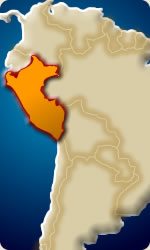|
|
| Weather |
Weather and climate vary with the regions. The coast has its summer from December to April. In the winter temperatures drop but it's still rainless. In the Andes April to October is the dry season, 20-25° C in the day and cold at night, sometimes below freezing. The rest of the year rain and a slight temperature drop. The jungle has its dry season from April to October with temperatures up to 35° C. During the rainy season there is heavy rainfall and high humidity.
|
| Currency |
The Peruvian currency is the Nuevo Sol consisting of 100 centimos. Banks, hotels and shops easily accept US Dollars. The most common US dollar exchange practice is through "cambistas" in the streets. These are people who display their calculators in one hand and currency bills in the other. Foreign money can be freely exchanged at any local bank or hotel.
Exchange rate varies between places make sure to ask if U.S. dollars are accepted and what the exchange rate is before making any purchases.
Travelers cheques are not very welcome in Peru. Banks will exchange them only at a high fee. Most businesses will not take them at all. Credit cards, such as American Express, Access/Mastercard, Diners Club and Visa are all accepted, but usage facilities may be limited outside the major cities.
|
| What to bring? |
Passport; travelers checks; first-aid kit (see our medical kit packing list for a list of suggested health supplies); Swiss army knife or leatherman; cloths for warm and cool weather as one can encounter both in an afternoon in the Andes or if traveling between regions; raincoat; backpack; money belt or neck pouch; watch with alarm clock; toilet paper and tampons; flashlight or headlamp; plastic bags for separating dirty and clean clothes and shoes; needle and thread; biodegradable soap (if in backcountry areas); notebooks and pens/pencils; hat; and sunglasses.
Leave copies your important documents, such as your passport, as well as travelers check and credit card numbers, with someone who can fax them to you if they are stolen and/or give a copy to a trusted traveling companion. E-mailing numbers to an on-line e-mail account on Hotmail or Yahoo is also a good idea since you can access the Internet from almost anywhere.
|
| Cost |
Travelling light is always recommended. You'll also need insect repellent (at least 30% DEET) and possibly a mosquito net (most hotels provide them). Malaria pills may also be necessary, read about the disease and how to prevent it in the malaria sub-section of our health page. |
| Andes |
| In most parts of the Andes, you can experience all four seasons in one day. Be prepared for cold nights and cold rain, especially if you plan on camping. Warm, fast drying clothes are recommended (synthetics and wool are good, but avoid cotton, especially directly against the skin). Good hiking boots that either dry quickly or are water-resistant are a must for most activities. For trekking through páramo, rubber boots work exceptionally well, even with a full pack. The general packing list plus these items will serve you well in the Andes. |
| Forest |
Rubber boots (a must since hiking boots don't work well in calf-deep mud - most lodges and arranged tours will provide boots up to size 10 or they can be purchased in most towns for about USD 5); mosquito net (most hotels and tour companies offer nets); insect repellent (with DEET); malaria pills; antihistamine tablets and an epi-pen for people with serious allergies to stings; water purification tablets (iodine is recommended); oral rehydration packets; binoculars (invaluable in the rainforest - it's worth spending a bit of extra money to get a good pair: 8 x 40 are excellent for poor light conditions under the forest canopy); plastic bags for keeping your clothes dry; swimming suit; lightweight quick drying clothes; at least one long-sleeved shirt; one pair of loose-fitting pants (no jeans); a light sweater (it gets surprisingly chilly in the rainforest, especially on boat trips); poncho that fits over you and your pack (the cheap plastic knee-length type coats are better than goretex, which will soak right through in a real rainforest deluge); bandana; a pair of clean socks for each day; Teva-like sandals or sneakers for around camp; and zip lock bags for food, books, maps and anything else you hope to keep dry.
All clothes (undergarments included) should be loose fitting to help keep you cool and to reduce your chances of being bitten by chiggers. |
| |
|

| Health |
| Recommended vaccinations are: diptheria, hepatitis A, polio, rabies, tetanus and typhoid. Yellow fever and malaria is compulsory when visiting jungle areas as Puerto Maldonado or Iquitos. |
| |
| Altitude Sickness |
| Visitors to high-altitude Andean destinations such as the Cusco and Lake Titicaca areas may need some time to adjust to the altitude. We recommend to rest at least 5 hours before taking a tour and to take light meals when arriving in Cusco or Puno. Altitude sickness and minor stomach upsets are common but brief. Avoid alcohol, cigarettes and heavy food. Drinking mate de coca (an infusion of coca leaves - and perfectly legal in Peru ) may help. If symptoms become more severe and prolonged it is best to quickly seek medical attention and make arrangements to descend to a lower altitude. On recovery one can re-ascend slowly or in stages. |
| |
| Travel Insurance |
| Before you travel make sure that you take out good travel and medical insurance |
|
|